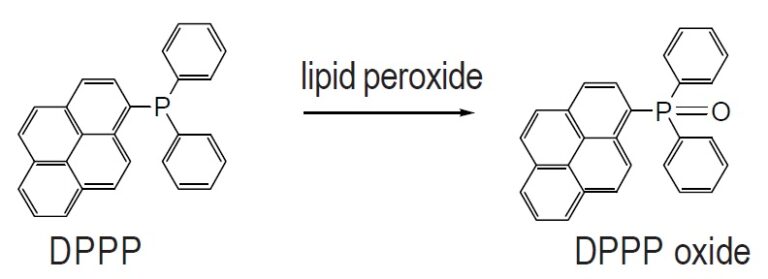DPPP

Stress Marker Detection
-
Product codeD350 DPPP
-
CAS No.110231-30-6
-
Chemical nameDiphenyl-1-pyrenylphosphine
-
MWC28H19P=386.42
| Unit size | Price | Item Code |
|---|---|---|
| 10 mg | Find your distributors | D350-10 |
Product Description
DPPP is a non-fluorescent triphenylphosphine compound. It reacts with hydroperoxide to generate DPPP oxide that emits fluorescence at 352 nm excitation and 380 nm emission wavelengths (Fig. 1). Post-column HPLC method is used to determine phospholipid peroxide in sample solutions.

Fig 1. DPPP reaction with lipid peroxidase
References
1. K. Akasaka, et al., Study on Aromatic Phosphines for Novel Fluorometry of Hydroperoxides(II) – the Determination of Lipid Hydroperoxides with Diphenyl-1-Pyrenylphosphine-. Anal Lett. 1987;20:797-807.
2. K. Akasaka, et al., An Aromatic Phosphine Reagent for the HPLC-fluorescence Determination of Hydroperoxides -Determination of Phosphatidylcholine Hydroperoxides in Human Plasma. Anal Lett. 1988;21:965-975.
3. K. Akasaka, et al., A Simple Fluorometry of Hydroperoxides in Oils and Foods. Biosci Biotech Biochem. 1992;56:605-607.
4. K. Akasaka, et al., High-performance Liquid Chromatography and Post-Column Derivatization with Diphenyl-1-Pyrenylphosphine for Fluorimetric Determination of Triacylglycerol Hydroperoxides. J Chromatogr. 1992;596:197-202.
5. K. Akasaka, et al., Simultaneous Determination of Hydroperoxides of Phosphatidylcholine, Cholesterol Esters and Triacylglycerols by Column-Switching High-Performance Liquid Chromatography with a Post-column Detection system. J Chromatogr. 1993;622:153-159.
6. K. Akasaka, et al., Normal-phase High-performance Liquid Chromatograohy with a Fluorimetric Postcolumn Detection System for Lipid Hydroperoxides. J Chromatogr A. 1993;628:31-35.
7. Y. Okimoto, et al., A Novel Fluoresceint Probe Diphenyl-pyrenylphosphine to Follow Lipid Peroxidation in Cell Membranes. FEBS Lett. 2000;474:137-140
Handling and storage condition
| Appearance: | Pale yellow powder |
|---|---|
| Purity (HPLC): | ≧ 97.0 % |
| Solubility in Chloroform: | To pass test (almost clear, colorless to slightly yellow) |
| IR spectrum: | Authentic |
| Protect from light, Nitrogen substitution |











